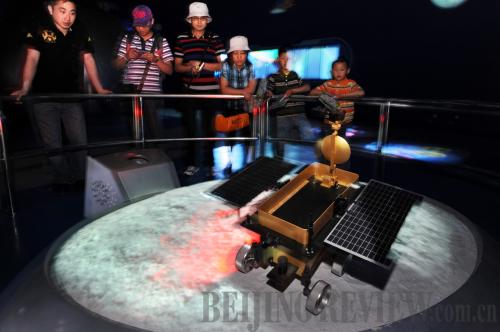|
 |
|
EYE-CATCHING: A lunar rover model designed by Chinese scientists is exhibited at the Space Pavilion at the World Expo site in Shanghai (LI ZIHENG) |
A nifty gold-colored vehicle equipped with two solar panel wings attracted the attention of many visitors to the Space Pavilion at the World Expo site in Shanghai. It was the model of the lunar rover for China's Moon probe program.
Thousands of years ago, ancient Chinese people boldly imagined living on the Moon. Now the country's scientists have designed their own lunar rovers, and plan to land one on the Moon in 2013.
"In the past, we could only observe the Moon; with a lunar rover, we can touch the Moon," said Hu Zhenyu, a researcher with the Shanghai Aerospace System Engineering Institute.
China's lunar probe program, also known as the Chang'e Program, kicked off years ago.
The first spacecraft in the program, an unmanned lunar orbiter named Chang'e 1, was launched in October 2007. The second unmanned moon orbiter, Chang'e 2, will be launched at the end of this year.
Unlike Chang'e 1 which circled the Earth for days before changing its path to near its orbit 200 km above the Moon, Chang'e 2 will go directly into orbit 100 km above the Moon.
Chang'e 2 is to prepare for the landing of the lunar rover, including selecting an appropriate landing site, said Ouyang Ziyuan, chief scientist of China 's lunar exploration program and an academician in Chinese Academy of Sciences (CAS).
Then the lunar rover carried by Chang'e 3 will land on the Moon. Its mission is to explore landscape, geological structure, minerals and chemical components of the Moon and to collect samples.
A lunar rover uses many of the world's most advanced technologies, including deep space communications, remote survey and control, moon-landing orbit design, soft landing technologies and the research and development of the moon probing robot.
Yang Junhua, Deputy Director of the Chinese Society of Astronautics, said many research institutes and universities in China participated in designing and developing lunar rovers, including the No. 5 Institute of the China Aerospace Science and Technology Corporation and Beijing University of Aeronautics and Astronautics. Each of them focused on one area. So far, about a dozen lunar rovers have been built.
The exact appearance of the lunar rover which will land on the Moon remains a mystery to the general public. Ye Peijian, Commander in Chief of the Chang'e Program and also an academician of the CAS, said it would look like the four lunar rover prototypes exhibited at the ninth China Hi-Tech Fair held in Shenzhen in 2007.
It would be light, agile, and adept at climbing slopes and steering away from obstacles, Ye said. Each wheel will have its own drive, and can adjust its height.
As the Moon's environment differs strikingly from the Earth, the lunar rover will face many challenges. It will work in a low-gravity vacuum, exposed to strong radiation and both extremely low and high temperatures. To protect the equipment from strong radiation, the lunar rover will be coated with gold.
| 